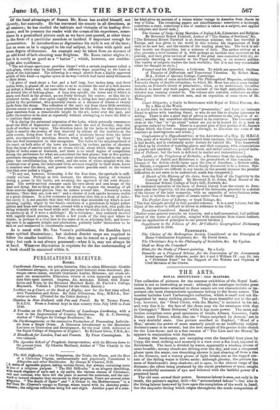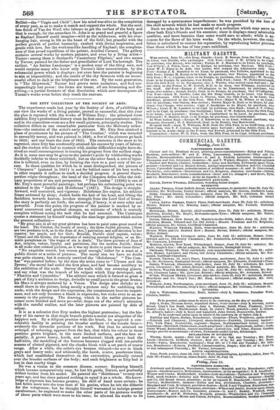THE ARTS.
ROYAL INSTITUTION : OLD MASTERS.
THE collection of pictures for the summer exhibition of the Royal Insti- tution is not so interesting as usual: although the catalogue includes great names, the specimens attached to those names are not characteristic or im- portant; the most characteristic specimens belong to the lesser names. The number includes Lord Yarborough's collection, which is small and not dis- tinguished by many striking pictures. The most beautiful one in the gal- lery, however, the " Dead Christ, with the Merles," is included in his set; and very fine it is: the face of the Jesus may vie for sweetness with that in Correggio's " Mater Dolorosa," while it has more power. The same col- lection comprises some good specimens of Guido, Albano, Guercino, Carlo Dolce; some Titians, which, like the " Diana surprised by Acteon," are in a very doubtful state. One picture ascribed to Raphael, " Head of a Man," attests the power of some masterly pencil on an indifferent subject Rubens's name is to several; but the best sample of his genius is the sketch for the Lion-hunt; and in a fine version of " The Lion and the Mouse," he appears in conjunction with Snyders.
Among the landscapes, not excepting even the beautiful frost piece by Cuyp, the most striking and masterly is a view over a flat land, imputed to Rembrandt. The land is divided by water, apparently a winding stream of some breadth; stormy clouds are driving over the sky, and cast a chequered gloom upon the scene; one drenching shower is just clearing off from a rise in the distance, and a watery gleam of light breaks out as the ragged cur- tain of the falling water is blown aside: although gloomy, the picture has none of Rembrandt's deep shadows; all is open, to the utmost verge of the distance; the effect being produced by the nicest gradations of tone, caught with wonderful acuteness of eye and followed with the faithful power of a practised hand.
The old men earned their power. Immense labour is seen, not only in its result, the painter's capital, skill—his "accumulated labour"—but also in the living labour bestowed by love upon the completion of the work in hand. See the exquisite feeling which reigns throughout the crude composition of Bellini—the " Virgin and Child"; how his mind was alive to the completion of every part, so as to make it match and support the whole. Not the soul- less finish of Van der Wed, who labours to get the surface of the body and that is enough; for the attendant St. John is as grand and graceful a figure as Raphael himself could imagine—wild as the wilderness, with his over- hanging hair, strong in life as the beast of the field; but graceful with the perfect growth of perfect humanity, exalted with divine inspiration, and gentle with love. See the workmanlike handling of Raphael; the complete.. ness of that proud republican of the palette, Annibal Caracci. The gallery contains several works by modern painters, and even by a living artist— Turner: among them is Stothard's "Canterbury Pilgrims," and two scenes by Turner, painted for the father and grandfather of Lord Yarborough. The earliest, " An Italian Landscape," is a modest copy of the thing seen, and would surprise many who know only Turner's later eccentricities, by the substantial power which it displays: yet even here the painter is beginning to aim at impossibility, and the centre of the sky ferments with an unsuc- cessful effort to dash at the brightness of the sun. By the next generation, in "The Shipwreck," Turner had grown more audacious, and had cor- respondingly lost power: the forms are looser, all are fermenting and dis- solving,—a partial foretaste of that dissolution which now decomposes all Turner's works even before they reach the canvass.



























 Previous page
Previous page